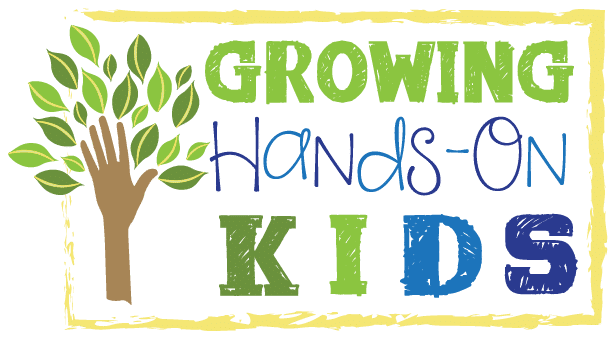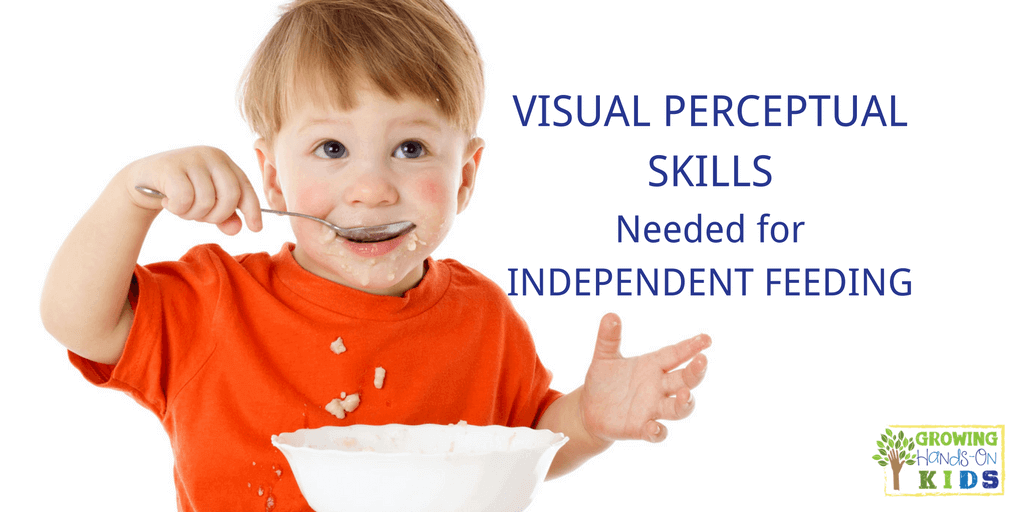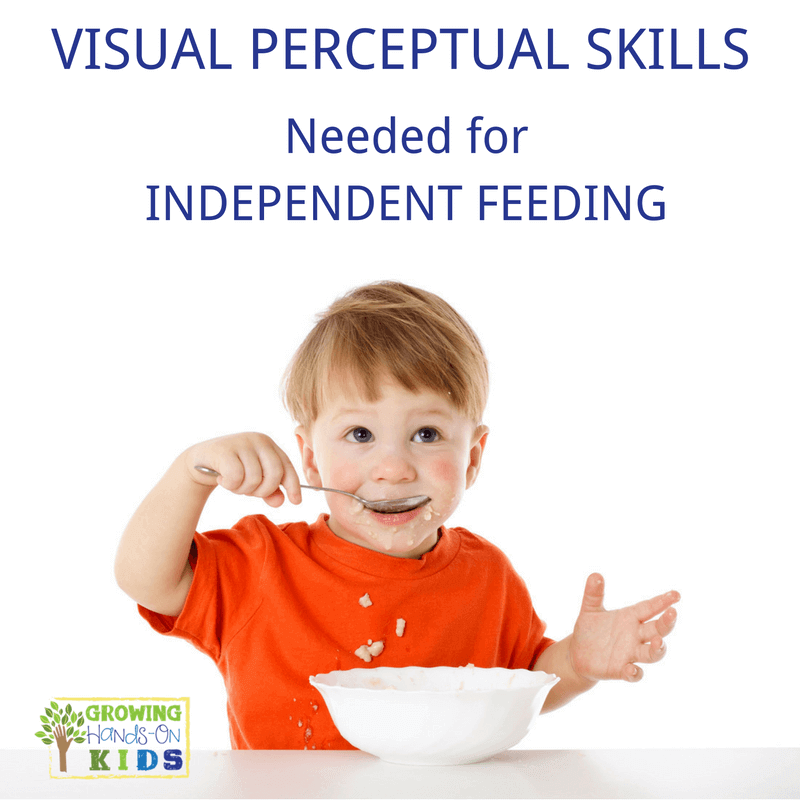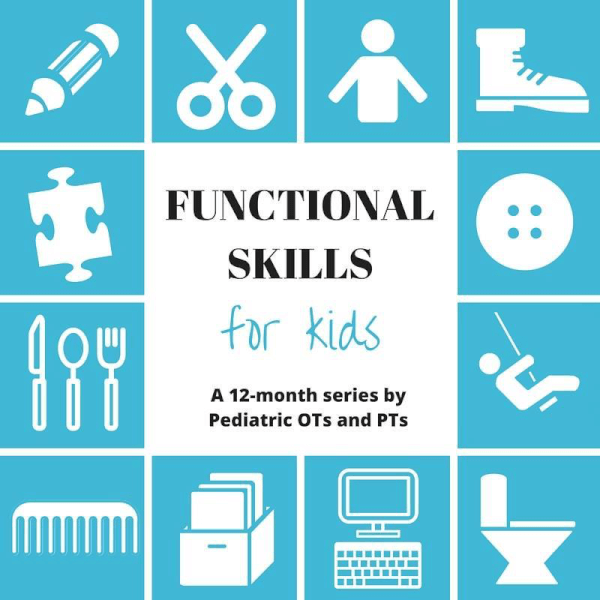Visual Perceptual Skills Needed for Independent Feeding
Affiliate and Referral links are used below to promote products I love and recommend. I receive a commission on any purchases made through these links. Please see my disclosure policy for more details. As an Amazon Associate, I earn from qualifying purchases.
A huge component of independence in feeding is the use of visual perceptual skills. Your eyes need to be able to process where the food is in relation to your hands and then tell your hands how much pressure to place on the fork or spoon in order to get food on it and bring it to your mouth. For children who have difficulty with self feeding, it is important to address their possible lack of visual perceptual skills needed for independent feeding.
What are Visual Perceptual Skills?
Before we continue to today's tips, I want to make sure we are all on the same page when it comes to terms and what they mean. There are a few different terms out there when it comes to visual perceptual skills and they can be a little confusing.
First up, visual motor skills include the development of visual perceptual skills, eye-hand coordination, and functional visual skills such as eye-tracking and convergence.
Visual perceptual skills involve the ability to organize and interpret the information seen from the eyes and give it meaning.
Visual motor integration means that the information received from the eyes to the hands is efficient and able to be used appropriately. (See visual motor integration skills).
Eye-hand coordination (also hand-eye coordination) “is the coordinated control of eye movement with hand movement, and the processing of visual input to guide reaching and grasping along with the use of proprioception of the hands to guide the eyes.” (source: eye-hand coordination)
Visual perceptual skills for just about everything we do in regards to self care, but let's take a look specifically at feeding today.
Task Analysis of Independent Feeding Skills
One thing we do as therapists is do a task analysis of a skill to see where a child or person may be having issues. So let's look at a general task analysis of a typical independent feeding activity.
- Ability to guide the body to a chair at the table, pull out that chair and then sit down.
- Able to visually discriminate between the different objects at the table (plate, cup, spoon, fork, knife, napkin etc) and pick up napkin appropriately and place it in the lap.
- Ability to pick up the appropriately utensil (fork for solids such as meat, spoon for liquids such as soup, when to use a knife for cutting a piece of meat) and place food item on the utensil.
- Ability to use opposite hand to assist in placing food on the utensil.
- Ability to bring item to the mouth without visually seeing where the mouth is on the face.
When you look at a baby who is just learning to feed themselves, you can see how they are working at perfecting these skills. Their visual perception is still being developed. They have not learned how to interpret the incoming proprioception information from their hands appropriately. Their eye-hand coordination is still being formed (if you are looking for a good resource on teaching baby to feed himself, check out this great article from CanDo Kiddo).
For children who's visual motor skills are not fully integrated, independence in feeding can be difficult because their brain is not interpreting the information from their eyes to their hands appropriately. They may have problems with the following skills:
- Judging how much force to put on a utensil to hold it (they may drop it or grasp it too tightly)
- Difficulty putting food on their utensil and then keeping it on that utensil as it goes to the mouth
- Missing their mouth and food falling off the utensil on their lap or floor
It's important to realize what is age appropriate as far as self feeding skills and that is addressed in another post below in the Functional Skills for Kids blog hop this month. However, if you have a child who is struggling with visual motor skills and the independent feeding skills appropriate for their age, here are some tips.
Tips for Independent Feeding with Visual Perceptual Difficulties
- Limit visual distraction at the table, such a busy table cloths or placemats. Solid colors and high contrast in colors is best. For example, white food should be placed on a colored plate, not a white plate. Foods that are bright in color should be placed on white or neutral plating to enhance the contrast between food items. (source: Mealtime Independence for the Visual Impaired).
- The same goes for placing plates, cups, and utensils on high contrast surfaces. If you have neutral or white plates, bowls, or cups, than use a high contrast table cloth or placemat so the items are easy to see. Bright colored items should go on neutral placemats or table cloths.
- Limit how many different foods you introduce at the same time to one or two. For example, needing to use a spoon for soup, a fork and knife to cut meat, or a fork to stab at something can be a lot of process at one time. Introduce each of these food items one at a time during the meal, allowing your child to focus on just the skills needed for that one item, instead of jumping back and forth.
- Have finger food options to limit the use of utensils. That's not to say you NEVER use utensils. Using utensils is still an important skill. However this goes back to limiting options and decreasing the stress at the dinner table. If there is an appropriate finger food option that will encourage self feeding and independence, then use it! 🙂
- If a child has difficulty with judging movements and knocks items off the plate or the plate off the table often, consider using a silicon placemat that will stick to the table. Heavier adaptive utensils are often easier to grasp and hold on to as well.
- Practice taking bites and using utensils appropriately in front of a mirror so your child can see where their mouth is in relation to their food or utensil.
- Often times typical plates or bowls do not give the child a high enough side to be able to work on scooping food on to the utensil, so using a divided plate or one with higher sides will help with this. Divided plates will also help a child identify foods easier and be able to tell which utensils to use for which items. It is also helpful to use for finger foods and dips.
- Encourage practice of independent feeding skills through play time activities such a having tea parties, playing in a small kitchen area, pretending to use utensils and table items during play.
- Encourage your child to participate in food-prep help. Not only is this excellent fine motor and visual motor skill practice, it encourages your child to try new things that they helped to prepare.
There are many other skills needed for independence with feeding and our therapy bloggers of the Functional Skills for Kids blog hop series have you covered today!
Fine Motor Skills For Mealtimes | Therapy Fun Zone
Postural Control, Gross Motor Development and Mealtime | Your Therapy Source
Attention, Behavior, and Meal Time Problems | Sugar Aunts
4 Ways to Modify Meal Times for Fussy Eaters | Your Kids OT
Mealtime Skills, Rituals & Play – Nurturing a Love for Food | Kids Play Space
15 Tips for Picky Eaters | The Inspired Treehouse
Positioning, Motor Skills, and Table Manners: What the Connection? | Miss Jaime OT
For more OT Tips like this one, check out my Occupational Therapy Tips Pinterest board.

Heather Greutman, COTA
Heather Greutman is a Certified Occupational Therapy Assistant with experience in school-based OT services for preschool through high school. She uses her background to share child development tips, tools, and strategies for parents, educators, and therapists. She is the author of many ebooks including The Basics of Fine Motor Skills, and Basics of Pre-Writing Skills, and co-author of Sensory Processing Explained: A Handbook for Parents and Educators.




Some wonderful suggestions to help with visual spatial skills. Adjusting the contrast of dinnerware with placemats and the table are things that can be easily changed! Thanks for the great tips.
Great post with so many helpful tips. The breakdown of the task of feeding is helpful to see really how involved visual perception is in meal time!
A great post full of info and tips! Visual perceptual skills are often overlooked, but they are so important! Many ‘children’s’ plates are colourful and covered in pictures, making it difficult to see the food – amazing how much of a difference plain crockery can make!
Informative post. Always amazed at the intricacies of a child’s visual perceptual skills and how they affect activities of daily living.